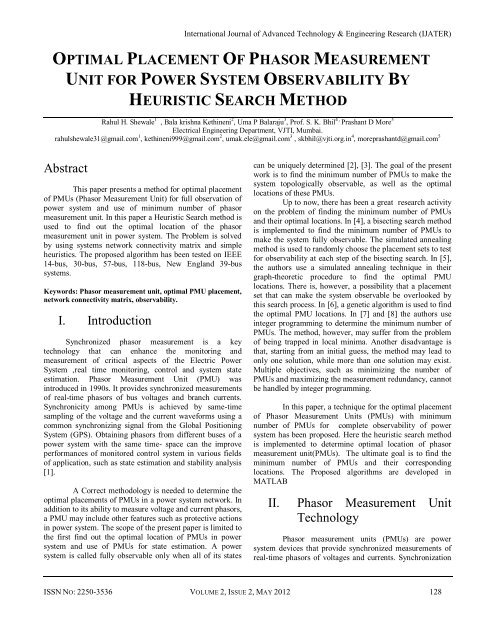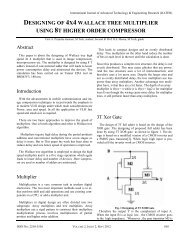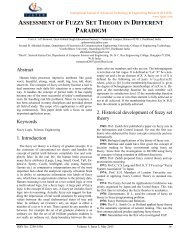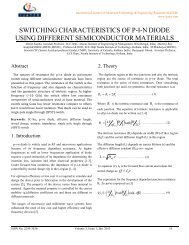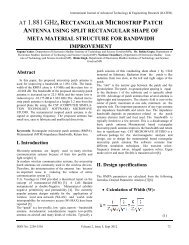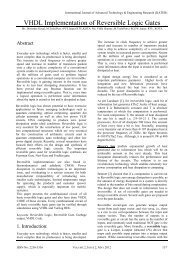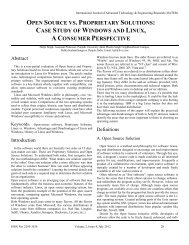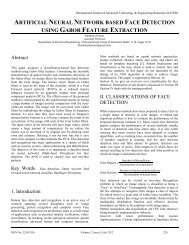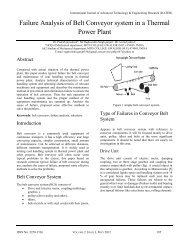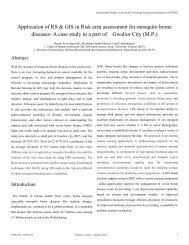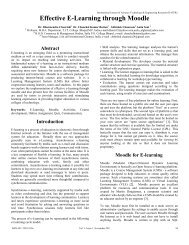optimal placement of phasor measurement unit for power ... - ijater
optimal placement of phasor measurement unit for power ... - ijater
optimal placement of phasor measurement unit for power ... - ijater
Create successful ePaper yourself
Turn your PDF publications into a flip-book with our unique Google optimized e-Paper software.
First we define some terms used in proposed method:1. Bus connectivity matrix: The Bus connectivitymatrix A represents bus connectivity in<strong>for</strong>mation <strong>of</strong><strong>power</strong> system network and is given in (2) <strong>for</strong> 7 bustest system.2. Isolated bus or Radial bus: The bus which isconnected to only one other bus is called as radialbus. In 7 bus test system bus 1 and 5 are the radialbuses.3. Zero injection bus (ZIB): Zero injection busses arethe busses from which no current is being injectedinto the system. If zero injection busses are alsomodelled in the PMU <strong>placement</strong> problem, the totalnumber <strong>of</strong> PMUs can be further reduced.4. Zero injection buses connected to radial buses(ZIBCRB): These are the zero injection busseswhich are connected to radial buses.5. Directly Observable buses (DOB):The busesconnected to PMU bus are called DOB. In 7 bustest system if bus 2 is the PMU bus then 1, 2,3,6,7are directly observable buses.6. Indirectly Observable buses (IOB): Buses whichare not connected to any PMU bus, but their <strong>phasor</strong>can be found out using KCL at ZIB. In IEEE 14 bussystem bus 7 is the ZIB and it is connected to bus 4,8, and 9. Among the buses 4, 7, 8 and 9, bus 4, 7and 9 are directly observable due to PMU at bus 9.Application <strong>of</strong> KCL at bus 7 provides voltage<strong>phasor</strong> <strong>of</strong> bus 8. Bus 8 is an IOB.7. Total Observable buses (TOB): It is the sum <strong>of</strong>DOB and IOB.Procedure <strong>for</strong> finding out <strong>optimal</strong> location <strong>of</strong> PMU:Step1. Form a bus connectivity matrix(A) from the networkdata.Step2. Find out the Isolated or Radial buses <strong>for</strong> the system.Also find buses connected to radial buses (BCRB).Step3. Remove the zero injection buses from the set <strong>of</strong>BCRB. Select remaining buses in the set as PMU <strong>placement</strong>bus.Step4. By using PMU bus selected in step3 find indirectlyobservable buses using KCL at zero injection bus.Step5. Find out Observability index <strong>of</strong> the each buses (OIB).OIB is the number <strong>of</strong> observable buses when placing PMUon respective bus. So <strong>for</strong> each bus value <strong>of</strong> OIB is different.Step6. Find out maximum value <strong>of</strong> OIB.i.e.OIB max, andselect the bus having maximum OIB.Step7. Form a set <strong>of</strong> buses having maximum OIB. Nowremove zero injection buses from the set. If the number <strong>of</strong>remaining buses are greater than zero go to step8,else checkwhether there is any bus in set connected to zero injectionbus connected to radial bus (ZIBCRB).If yes select that busas PMU <strong>placement</strong> bus and go to step9.If no reduce value <strong>of</strong>maximum OIB by one and go to Step6.else findunobservable buses(UOB) and select any bus from ZIBCRBconnected to UOB as PMU bus and go to Step9.Step8. If the number <strong>of</strong> buses found in step7 is one select thebus as PMU bus and go to step9.If the number is the morethan one check <strong>for</strong> the non zero injection bus connectivityamong the buses obtained in Step7.Step9. Find directly observable buses and indirectlyobservable buses and find out total observable buses.Step10. If TOB is equal to the total number <strong>of</strong> the systembus then system becomes completely observable. Go tostep11.Else if TOB
Radial Buses Injection BusesIEEE 118-Bus 19,73,87,111,112 5,9,30,37,38,63,64,68,71,81New England39 Bus.30.31,32,33,34,35,36,37,38.1,2,5,6,9,10,11,13,14,1719,22.The simulation results <strong>of</strong> the test systems areexplained in table number 2.Proposed method results arecompared with the PMU <strong>placement</strong> by using non-linearconstraints equation method. The last column in the table 2shows the simulation results obtained by proposed method.This column shows the <strong>optimal</strong> strategic bus locations wherePMU must be placed in order to make system fullyobservable. The result obtained by using proposed methodare compared with the the result documented in reference[15]. ( using non-linear constraints equation).Result <strong>of</strong> themethod using non-linear constraints equation are shown insecond column <strong>of</strong> table 2.The proposed heuristic approach provides minimum <strong>optimal</strong>locations <strong>of</strong> PMU buses <strong>for</strong> complete observability <strong>of</strong> thesystem.Table 2.Optimal locations <strong>of</strong> PMU <strong>for</strong> IEEE Test systems.Test System Result <strong>of</strong> [15]. Result <strong>of</strong> ProposedMethodIEEE-14 Bus 2,6,9.(three PMUs)2,6,9.(three PMUs)Test System Result <strong>of</strong> [15]. Result <strong>of</strong> ProposedMethodIEEE-30 Bus Method(a):3,5,10,12,18,23,27.(seven PMUs)Method(b):2,3,6,10,12,18,23,27(eight PMUs)2,3,10,12,15,19,27.(seven PMUs)IEEE-57 BusIEEE-118 BusMethod(a):1,6,9,15,20,25,27,32,38,47,50,53,56.(thirteen PMUs)Method (b):1,5,9,14,15,20, 25,28,32,50,53,56.(twelve PMU)Method (a):2,8,11,12,15, 19,21,27,31,32,34,40,45,49,52,56,62,65,72,75,77,80,85,86,90,94,101,105,110(twenty ninePMUs)Method (b):1,6,9,15,20,25,29,32,38,51,53,56.(twelve PMUs)2,8,11,12,15, 19,21,27,31,32,34,40,45,49,52,56,62,65,72,75,77,80,85,86,90,94,101,105,110(twenty eightPMUs)New England39 Bus system2,8,11,12,17,21,25,28,33,34,40,45,49,52,56,62,72,75,77,80,85,86,90,94,101,105,110,114(Twenty eightPMUs).Not Available. 3,8,13,16,20,23,25,29(eight PMUs).The simulation result obtained by proposed methodis compared with result <strong>of</strong> [15]. Author‟s [15] treat zeroinjection <strong>measurement</strong> in two different ways such as a)Forming non-linear constraints, b) Topology trans<strong>for</strong>mation.Results <strong>of</strong> the two approaches are documented in the tables5, 7 and 8. For IEEE-30 bus system method (a) gives<strong>optimal</strong> number (seven) and their strategic location, whereas<strong>for</strong> IEEE- 57 bus system method (b) gives the <strong>optimal</strong>number (twelve) and their strategic locations. It is not clearwhich method will give the <strong>optimal</strong> solution <strong>for</strong> whichsystem. For any system both the method is to be executedand compared <strong>for</strong> obtaining <strong>optimal</strong> solution. The proposedmethod provides <strong>optimal</strong> solution in all cases studied.VI. ConclusionThe problem <strong>of</strong> <strong>optimal</strong> placemat <strong>of</strong> PhasorMeasurement Unit is solved in this paper by using simpleheuristic search method to make the system completelyobservable. In this we had used simple heuristics based onthe network in<strong>for</strong>mation <strong>for</strong> determination <strong>of</strong> minimum set<strong>of</strong> Phasor Measurment Units. The proposed methodsuccessfully overcomes the limitation <strong>of</strong> conventionalinteger programming method in producing systemindependent <strong>optimal</strong> solution when considering zeroinjection buses. The proposed method is very fast inproviding <strong>optimal</strong> solution as compared to other exhaustivesearch method. The Simulation results obtained <strong>for</strong> differentnetwork shows the effectiveness <strong>of</strong> the proposed method infinding the minimum number <strong>of</strong> PMU bus locations <strong>for</strong>complete observability assessment <strong>of</strong> Power Systems.Themethod is general and is applicable to all <strong>power</strong> systemnetworks.VII. References[1] A. G. Phadke, J. S. Thorp, and K. J. Karimi,StateEstimation with Phasor Measurements," IEEETransactions on Power Systems, Vol. 1, No. 1, pp.233-241, February 1986.[2] A. Monticelli, ‘State Estimation in ElectricPowerSystems: A Generalized Approach’. Boston,MA: Kluwer, 1999.ISSN NO: 2250-3536 VOLUME 2, ISSUE 2, MAY 2012 132
[3] A. Abur and A. G. Exposito, Power System StateEstimation: Theory and Implementation. New York:Mercel Dekker, 2004.[4] T. L. Baldwin, L. Mili, M. B. Boisen, and R. Adapa,“Power system observability with minimal <strong>phasor</strong><strong>measurement</strong> lacement,” IEEE Trans. Power Syst.,vol. 8, no. 2, pp. 707–715, May 1993.[5] R. F. Nuqui and A. G. Phadke, “Phasor <strong>measurement</strong><strong>unit</strong> <strong>placement</strong> techniques <strong>for</strong> complete andincomplete observability,” IEEE Trans. Power Del.,vol. 20, no. 4, pp. 2381–2388, Oct. 2005.[6] B. Milosevic and M. Begovic, “Nondominatedsorting genetic algorithm <strong>for</strong> <strong>optimal</strong> <strong>phasor</strong><strong>measurement</strong> <strong>placement</strong>,” IEEE Trans. Power Syst.,vol. 18, no. 1, pp. 69–75, Feb. 2003[7] B. Xu and A. Abur, “Optimal <strong>placement</strong> <strong>of</strong> <strong>phasor</strong><strong>measurement</strong> <strong>unit</strong>s <strong>for</strong> state estimation,” FinalProject Report, PSERC, Oct. 2005.[8] B. Xu and A. Abur, “Observability analysis and<strong>measurement</strong> <strong>placement</strong> <strong>for</strong> systems with PMUs,” inproc. IEEE Power Eng. Soc. Power Systems Conf.Expo., Oct. 2004, pp. 943–946.[9] Bindeshwar Singh , N.K. Sharma , A.N. Tiwari, K.S.Verma,andS.N. Singh, “Applications <strong>of</strong> <strong>phasor</strong><strong>measurement</strong> <strong>unit</strong>s (PMUs) in electric <strong>power</strong> systemnetworks incorporated with FACTS controllers”,International Journal <strong>of</strong> Engineering, Science andTechnology Vol. 3, No. 3, 2011, pp. 64-82.[10] William Yuill, Non-Member, A. Edwards, Nonember,S. Chowdhury, Member, IEEE, and S. P.howdhury, Member, IEEE ,“ Optimal PMU<strong>placement</strong>:A comprehensive literature review,” IEEETrans 2011.[11] B. Xu, A. Abur, “Observability Analysis and<strong>measurement</strong> <strong>placement</strong> <strong>for</strong> system with PMUs," inProc. 2004 IEEE Power System Conf. Expo, vol. 2,pp. 943-946.[12] Kazem Mazlumi and Hesan Vahedi , Non members,„Optimal Placement <strong>of</strong> PMUs in Power SystemsUsing Mixed Integer Non Linear Programming andBacterial Foraging Algorithm‟. ECTI Transaction onelectrical engg.Electronics,and Communications volno.9 no.1 February 2011.[13] R.Christie, Power System Test Archive, Aug. 1999.[Online].Available:http://www.ee.washington.edu/research/pstca.[14] M.A.Pai, Energy Function Analysis <strong>for</strong> PowerSystem Stability. Norwell, MA: Kluwer, 1989.[15] B.Xu and A.Abur, „Optimal Placement <strong>of</strong> PhasorMeasurement Units <strong>for</strong> State Estimation,‟ FinalProject Report,PSERC, Oct. 2005.ISSN NO: 2250-3536 VOLUME 2, ISSUE 2, MAY 2012 133


